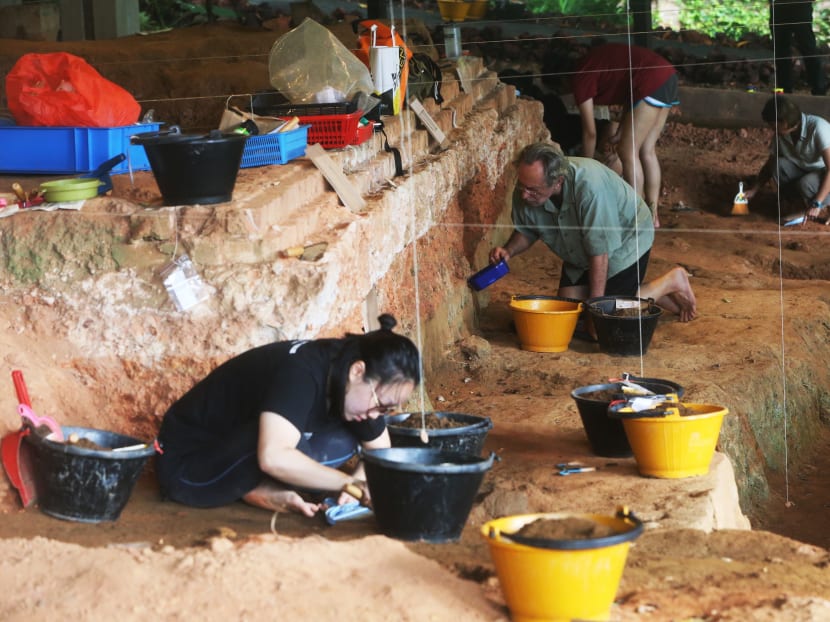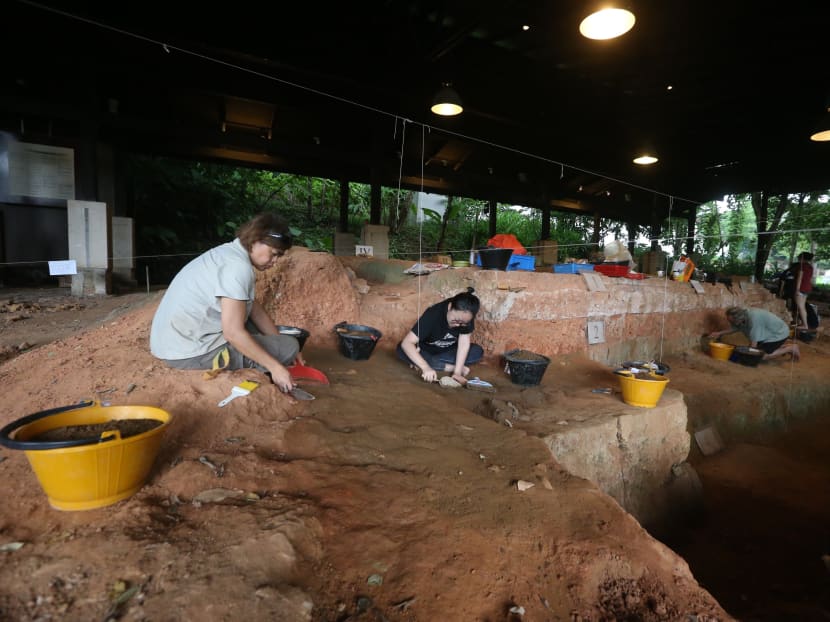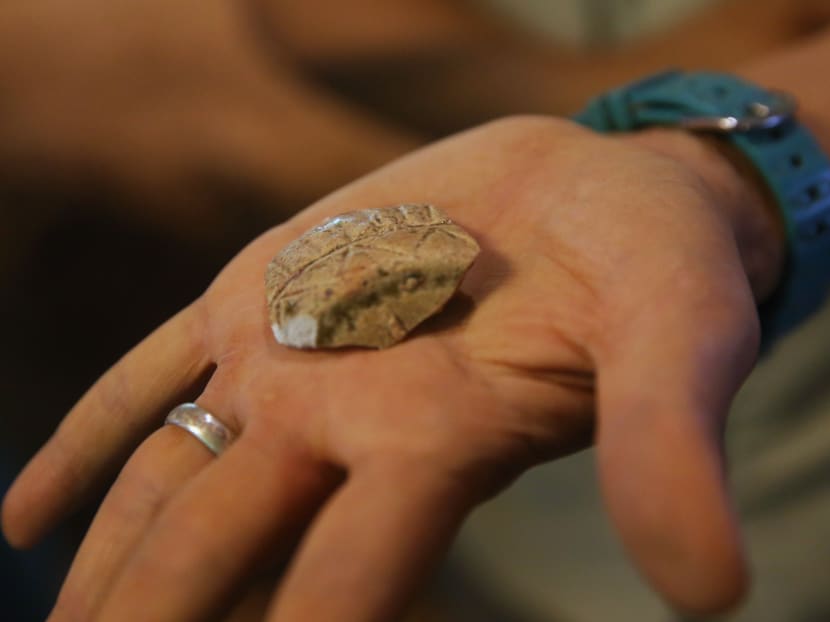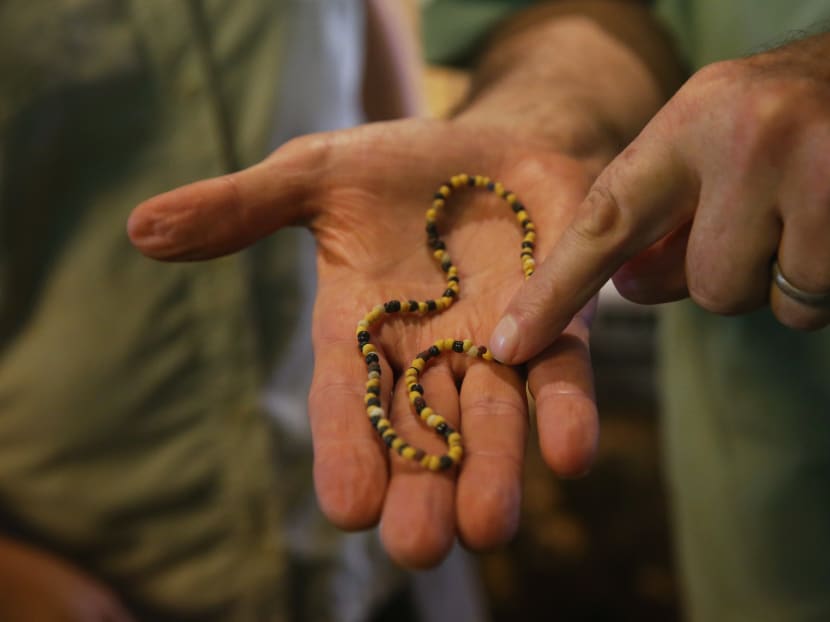Digging Fort Canning Park: Refreshed archaeological site, restored gardens to open by June 2019
SINGAPORE — Several new attractions showcasing the rich history of Fort Canning Park will be ready by June next year, breathing fresh life into the 18-hectare site.

Invited archaeologist Dr John N. Miksic (centre) and volunteers working at the Archaeological dig exhibition at Fort Canning Park.
SINGAPORE — Several new attractions showcasing the rich history of Fort Canning Park will be ready by June next year, breathing fresh life into the 18-hectare site.
Three historical gardens that will be restored will be ready by then, in conjunction with the bicentennial exhibition that will be held at the Fort Canning Centre, said the National Parks Board (NParks) on Sunday (Oct 28).
A 17-year-old exhibition space that features an archaeological dig site will be closed from next month to June next year for improvement works. When it reopens, the space will be renamed Artisan’s Garden as it is believed to be the site of a 14th-century palace workshop.
The improved site will allow visitors to view more objects that reflect the activities that happened on Fort Canning Hill between 1300 and 1400. This was when Temasek, as Singapore was then known, was said to be a major trading port.

The site will have a wider gallery space, new multimedia panels, and displays featuring finds from the latest dig by National University of Singapore archaeologist John Miksic and Nanyang Technological University (NTU) historian Goh Geok Yian.
NParks partnered the pair to explore portions of the site that were left intact during earlier excavations, to make the updated showcase more comprehensive and turn up new discoveries. The last dig at the site was in 1999, and the latest started on Sept 2 and ended on Sunday.
Among the finds from the latest dig is a Thai ceramic piece from Sawankhalok in central Thailand, said Associate Professor Goh, associate chair for research at NTU’s School of Humanities.

The object, found by student volunteer Caroline Ang, could date to the 14th century as the hill was abandoned just before the turn of the 15th century.
This could potentially challenge the view held by most archaeologists, who believe that Sawankhalok ware was produced in the 15th century, said Assoc Prof Goh.
Another similar piece was found at a different part of the hill in 1984.
Assoc Prof Goh said the Thai ceramic item was likely a royal gift brought here by a representative of the Thai king Ayutthaya, whose kingdom was founded in 1351.
Other finds at the site include green and white porcelain, and China-made glass beads dating back to the Yuan Dynasty, which were exported here as ornaments.


NParks said the dig uncovered more evidence of economic activities that took place on the hill in the 14th century.
Noting that the latest dig turned up about 200 to 300 objects, Prof Miksic said: “They were stringing (the beads) right at this place. What were they stringing them on? That’s a mystery. Was it on slippers, handbags, necklaces? We don’t know. But it could be an early manifestation of a Peranakan-type culture.”
Said Assoc Prof Goh: “What this demonstrates is that Singapore does have a long history, a full 700 years… it’s also important for Singaporeans to also think about being a part of South-east Asia.”
When it reopens, the Artisan’s Garden will have artefacts from the 14th to 19th century on display. It will also have a new outdoor garden and a sand pit for “mock digs” with archaeological tools.
Mr Wong Tuan Wah, NParks’ group director for the Fort Canning Park and Istana, said the agency may set up a Young Archaeologist Programme, where participants could be taught how to carry out an archaeological dig, in partnership with Prof Miksic and Assoc Prof Goh. Details will be fixed at a later date.
SHOWCASE FOR SINGAPORE’S BICENTENNIAL
In February, National Development Minister Lawrence Wong announced that Fort Canning Park would host Singapore’s bicentennial showcase next year, which marks the 200th year since Sir Stamford Raffles landed in Singapore.
The three historical gardens to be restored are the Royal Garden, First Botanic Garden and Jubilee Park.
For example, the Royal Garden will be designed to evoke the feel of a 14th-century garden, showcasing fruit trees like rambutan and jackfruit, and fragrant plants like gardenias and magnolias.
A series of re-curated heritage trails, including a 19th-century one that will feature the new Raffles and Farquhar Gardens, will also be ready by June next year.
A part of Armenian Street, which runs adjacent to the hill, will be pedestrianised and turned into a park featuring spices, among other things. It will open progressively from the first quarter of next year.
Meanwhile, NParks is exploring the permanent closure of a 200m stretch of road along Canning Rise, to allow visitors to walk more easily from Farquhar Garden to Fort Canning Green.
The stretch is not heavily used and any closure will not affect vehicular access to nearby establishments, although some drivers will have to make a detour, said Mr Wong.
Since January, NParks has been consulting stakeholders such as the National Museum of Singapore and the Registry of Marriages.
It has also been in talks with the Land Transport Authority, and will decide on the road closure by the end of this year.
DOWN MEMORY LANE: FORT CANNING HILL IN THE 14TH CENTURY
According to the National Library Board’s Infopedia page:
• The summit of Fort Canning Hill, also famously known as the Forbidden Hill or Bukit Larangan, is believed to be grounds of the royal palace of ancient Malay rulers in the 14th century
• Along the slopes of the hill, early colonial settlers had found the ruins of 14 sandstone blocks, pointing to a large palatial building dating to the 14th century
• Also observed were large fruit trees, including durians and rambutans, which signalled the presence of a palatial garden
• The hill was also believed to be the resting place of the last king of Singapura, Iskandar Shah
• Iskandar was king of Singapura until the Majapahit empire invaded the island in 1398
• The hill was then abandoned as it was said to be haunted








